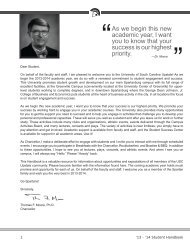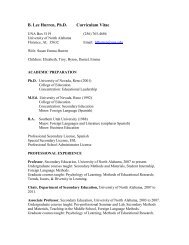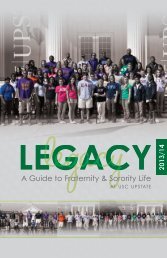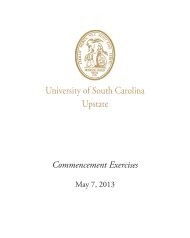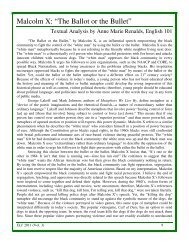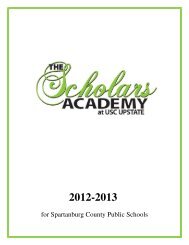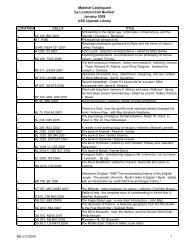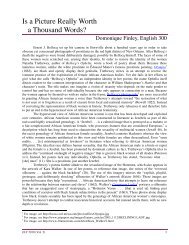The Identity Crisis of the Modernist Era
The Identity Crisis of the Modernist Era
The Identity Crisis of the Modernist Era
You also want an ePaper? Increase the reach of your titles
YUMPU automatically turns print PDFs into web optimized ePapers that Google loves.
public personality, and lifestyle; but everything he does now has double meanings. His quest for <strong>the</strong> Americandream seems capitalist in nature, but it is for an immaterial purpose once that illusion is broken. His desire forwealth is a tactic used to achieve what he considers success, which is to win Daisy’s heart. This type <strong>of</strong> success,although not exactly moral, is immaterial and supports <strong>the</strong> argument for Americanism being a moral standard <strong>of</strong>living. Although capitalism is a factor in Gatsby’s success, it is not <strong>the</strong> driving force; <strong>the</strong>refore, it is notAmericanism according to him.<strong>The</strong> final moments <strong>of</strong> <strong>the</strong> novel begin with <strong>the</strong> death <strong>of</strong> Jay Gatsby. When Nick finds him floating dead inhis own pool and muses about <strong>the</strong> world that Gatsby may have discovered if he had finally realized that his dreamwas a hopeless cause. <strong>The</strong> statement, “A new world, material without being real, where poor ghosts, breathingdreams like air, drifted fortuitously about” (Fitzgerald 169). Although Nick is literally describing <strong>the</strong> worldGatsby may have reluctantly discovered in his final moments, <strong>the</strong> text actually describes Gatsby as an individualas well. Although he sought <strong>the</strong> immaterial, he has become materialistic in <strong>the</strong> new world <strong>of</strong> West Egg. He hadchanged his name and was not real and now he was only a name, a ghost <strong>of</strong> who he once was during life. At <strong>the</strong>end <strong>of</strong> <strong>the</strong> novel, Nick regains sight <strong>of</strong> Americanism and moves back to <strong>the</strong> Midwest because <strong>of</strong> <strong>the</strong> lack <strong>of</strong>morals <strong>of</strong> <strong>the</strong> Eggs. <strong>The</strong> “body <strong>of</strong> people united as a nation” as described by Lowrie has broken as everyonemoves <strong>the</strong>ir separate ways and now even “national” identities are in crisis.Nick fur<strong>the</strong>r raises this conflict between capitalism and morality in terms <strong>of</strong> national identity andAmericanism at <strong>the</strong> end <strong>of</strong> <strong>the</strong> novel. By stating that Tom and Daisy “retreated back into <strong>the</strong>ir money or <strong>the</strong>ir vastcarelessness or whatever it was that kept <strong>the</strong>m toge<strong>the</strong>r, and let o<strong>the</strong>r people clean up <strong>the</strong> mess <strong>the</strong>y had made,”Nick creates a perspective that perhaps wealth can take <strong>the</strong> place <strong>of</strong> morality in defining <strong>the</strong> identity <strong>of</strong> anindividual. <strong>The</strong> article and supplement titled “What is Americanism?” provides insight into an issue that wasoccurring back in <strong>the</strong> early twentieth century during <strong>the</strong> modernist era. As <strong>the</strong> United States was undergoing massdevelopment and improvements following <strong>the</strong> First World War, it is easy to consider that a struggle betweenmaterial wealth and morality would develop. <strong>The</strong> ego <strong>of</strong> <strong>the</strong> nation was also developing at this time as schoolswere teaching nationalistic ideas and had an “emphasis on citizenship” in which <strong>the</strong>y taught <strong>the</strong> importance <strong>of</strong>being a good citizen (Pierce 119). Pierce also comments that this national growth was nothing new as nationalismhad always “been conditioned by contemporary social, economic, and political thought” even before <strong>the</strong> CivilWar (117). This conflicts with <strong>the</strong> view that Evans held decades later in which he stated that <strong>the</strong> issue <strong>of</strong> identityin <strong>the</strong> modernist era was not exactly timeless, but ra<strong>the</strong>r unique to this era in American history. Could <strong>the</strong> reaction<strong>of</strong> struggling between morals and material possessions really be a phenomenon that occurred only in thisparticular era <strong>of</strong> national growth? No, but <strong>the</strong> particular historical context raised <strong>the</strong> issue to prominence andsparked a modernist crisis <strong>of</strong> identity.<strong>The</strong> issue <strong>of</strong> identity was perhaps such a historically-specific phenomenon because <strong>of</strong> <strong>the</strong> fact that <strong>the</strong>United States was still a young country and <strong>the</strong> First World War had been <strong>the</strong> first opportunity for <strong>the</strong>m to enter<strong>the</strong> international arena. <strong>The</strong> identity <strong>of</strong> <strong>the</strong> nation as a whole seemed to reflect those <strong>of</strong> <strong>the</strong> individual identitiesthat composed it, which supports <strong>the</strong> claim about unity among peoples by Lowrie in “Nationalism.” <strong>The</strong> unity <strong>of</strong>peoples is also expressed in an article by Arthur Feiler, titled “Economic Nationalism,” albeit in a differentcontext. In his article, his discussion links <strong>the</strong> ideas <strong>of</strong> morality to <strong>the</strong> development <strong>of</strong> <strong>the</strong> capitalism <strong>of</strong> <strong>the</strong>country during this time period. According to him, <strong>the</strong> “spiritual attitude” <strong>of</strong> <strong>the</strong> country that included <strong>the</strong> idea <strong>of</strong>free trade became known as “economic nationalism” (Feiler 203). As <strong>the</strong> article continues, he explains that <strong>the</strong>nation still undergoes post-war problems twenty years after <strong>the</strong> First World War ended. However, America is not<strong>the</strong> only country enduring a deep sense <strong>of</strong> nationalism because <strong>of</strong> <strong>the</strong> war. According to Lowrie, national identityis formed by <strong>the</strong> union <strong>of</strong> individual identities. Feiler uses this idea to relate nationalistic emotion to <strong>the</strong> growth <strong>of</strong>state powers in <strong>the</strong> economy <strong>of</strong> <strong>the</strong> United States as well as <strong>the</strong> growth <strong>of</strong> private economic interests. As bothtypes <strong>of</strong> identities develop, so does <strong>the</strong> capitalism <strong>of</strong> <strong>the</strong> country.So how does <strong>The</strong> Great Gatsby engage and respond to <strong>the</strong> issue <strong>of</strong> identity in <strong>the</strong> modernist era? Afteranalyzing <strong>the</strong> characters and locations <strong>of</strong> <strong>the</strong> text, <strong>the</strong> reader will undoubtedly notice <strong>the</strong> struggle betweenmorality and materialism at least in <strong>the</strong> character <strong>of</strong> Jay Gatsby. His attainment <strong>of</strong> vast wealth and popularity areresults <strong>of</strong> a quest for <strong>the</strong> heart <strong>of</strong> a woman named Daisy Buchanan who is also a key to <strong>the</strong> capitalist class. Thisparticular series <strong>of</strong> actions parallels what Feiler was stating about capitalism taking root in <strong>the</strong> “spiritual attitude”<strong>of</strong> <strong>the</strong> nation in his article. Capitalism and material wealth may have been <strong>the</strong> major outcomes <strong>of</strong> bothcircumstances, but <strong>the</strong>y had begun merely as factors in a quest for something immaterial. However, <strong>the</strong> character<strong>of</strong> Gatsby diverges from a parallel with America once one looks at <strong>the</strong>ir search for a place in <strong>the</strong> world. During<strong>the</strong> modernist era, <strong>the</strong> United States was still trying to find it place in <strong>the</strong> world especially since a large proportionELF 2009 (Vol. 1) 18




